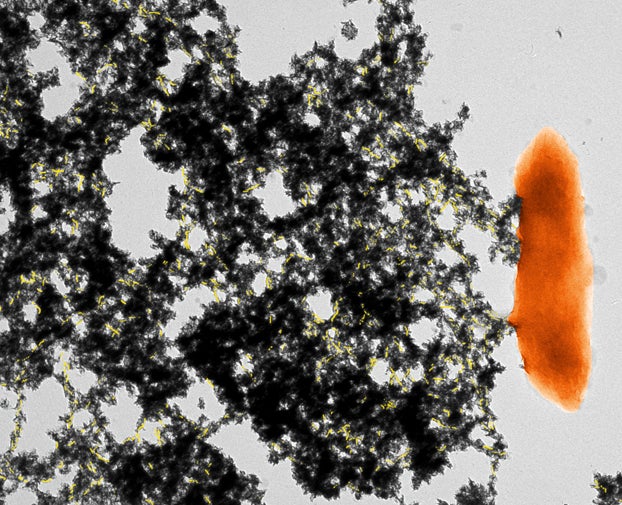核廃棄物をたべるバクテリアの謎が解明される。

-
Analysis by Jesse Emspak
Fri Sep 9, 2011 12:55 PM ET
Bacteria can clean up toxins, oil spills and nuclear waste, essentially by eating the stuff. But until now nobody was quite sure how they did it. Gemma Reguera and her team at Michigan State University found that the key is a structure called the pilus, a hair-like appendage that acts like a wire.
バクテリアは毒物、油漏れ、そして核廃棄物をきれいにできます。 本質的に食べることによってです。 しかし、いままで、なぜそんなことができるのか、だれにも解りませんでした。 ミシガン大学のGemma Regueraと彼女のチームは、その秘密の鍵が、PILUSと呼ばれる髪の毛状の付属器官がワイヤの役割をはたしている、にあることを発見しました。
The bacteria, called Geobacter sulfurreducens, transfer electrons via the pilus to the metals that they feed off of. Transferring the electrons gives the bacteria energy. It also changes the ionization state of the metal, changing it to a form that precipitates out of water. A colony of Geobacter living near a pile of nuclear waste would extract the uranium, making it easier to handle and remove.
このバクテリア、Geobacter Sulfurreducens は、食べようとする金属に繊毛をとおして電子を送ります。電子の移動がバクテリアにエネルギーを与えます。また、金属のイオンの状態を変え、溶けていた水からでて凝結します。核廃棄物の周辺にすんでいるジオバクターのコロニーは、ウランを抽出し、取り扱いやすくし、取り除くことができます。
NEWS: Nanowires Create World's Tiniest Battery
That was all very well, and the electron transfer has even been proposed as a way to build biological batteries. But an outstanding question was how Geobacter kept the uranium (and other chemicals) in nuclear waste away from their cellular walls, where the waste could cause damage. To see what role they played it was necessary to get a bunch of bacteria to grow lots of them in a lab. Reguera's team did that by exposing the bacteria to much harsher conditions than they were used to, stimulating them to grow more pili.
これはすばらしいことで、この電子の移動と利用した生物電池の構築も計画されました。 しかし、懸案は、ジオバクターがどのようにして、ウランやそのほかの化学薬品を細胞壁、損傷をうけるであろう、から離しておくことができるかという謎でした。 この謎をとくために研究所のなかで大量のバクテリアを繁殖させる必要がありました。 彼女のチームは、より過酷な環境にバクテリアたちをさらすことにより、繊毛のより多い成長をうながしました。
What they found was that the pili act as a buffer between the bacteria and the metallic compounds. The pili are quite long relative to the bacteria, and form a conductive barrier. That barrier is also a big part of the reason Geobacter can live in environments that would kill many other organisms.
彼らが発見したのは、繊毛がバクテリアと金属コンパウンドとの間のバッファとして働いていたことです。バクテリアのおおきさに比較して繊毛はとても長く、導電性バリアを形成しました。 そのバリアのおかげでほかの生物たちが死んでしまうような環境でも彼らが生活できるのです。
NEWS: Humble Weed Could Feed The World
The team published their work in the Proceedings of the National Academy of Sciences. In the paper they note that knowing how Geobacter species work makes it easier to come up with strategies to clean up toxic spills. It might even allow researchers to design tiny robots to do the job, or come up with ways to grow better toxin-eating bacteria.
チームはその成果を全米科学アカデミーの紀要に発表しました。そのなかで、どのようにジオバクター種が機能しているのかを知ることは、毒性流出を掃除するための戦略を考えだしやすくすると述べています。 研究者たちはその仕事をするちいさなロボットを設計するかもしれません。あるいは、よりよい毒を食べるバクテリアを育てる方法を考え出すかもしれません。
Photo: Geobacter cell (in orange) with the nanowires (in yellow) interspersed through the uranium (black material). Credit: Dena Cologgi and Gemma Reguera (Michigan State University).
ふーんそうなの。。。だれ~? EM菌には科学的根拠がないって
いっている人達は~っ!!!
source:
http://news.discovery.com/tech/how-bacteria-clean-up-nuclear-waste-110909.html
